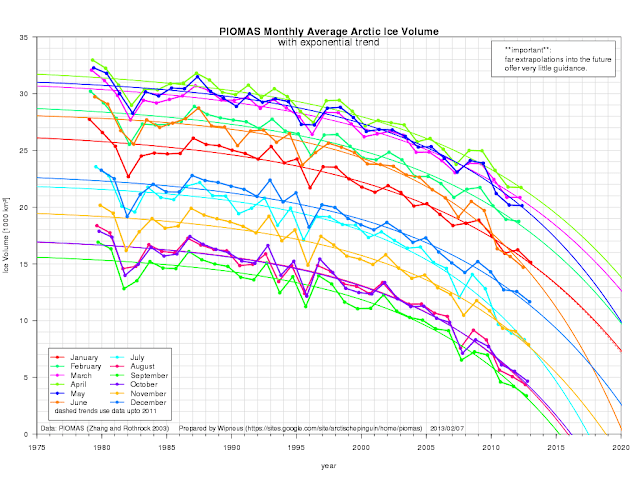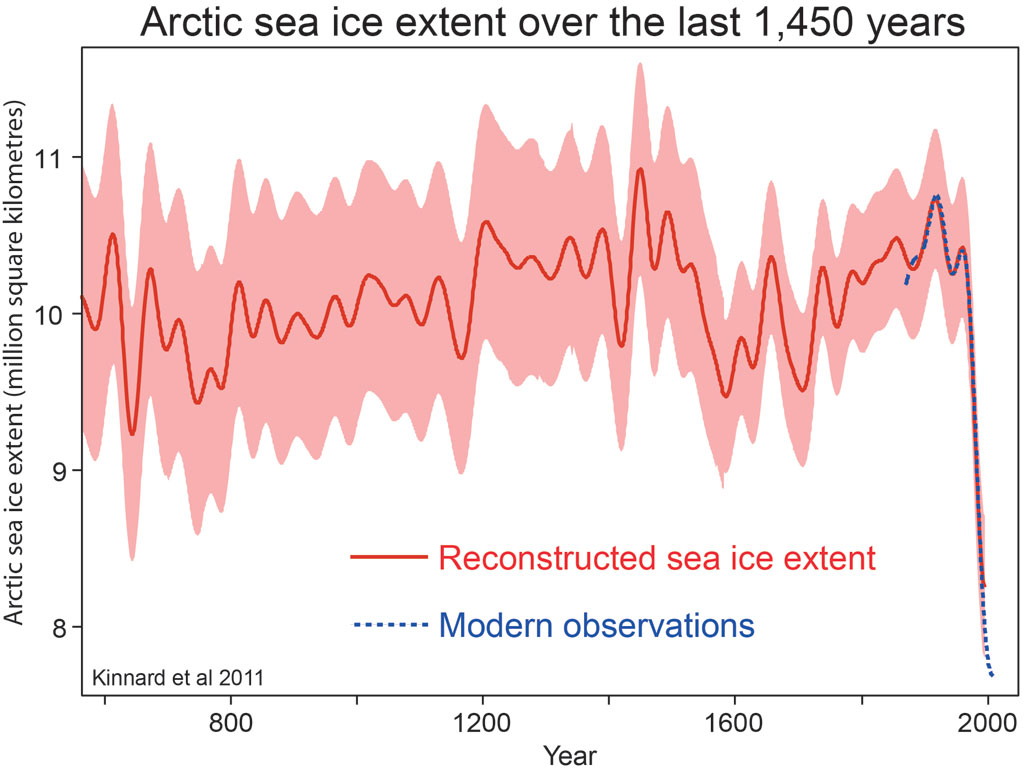Navigation
Install the app
How to install the app on iOS
Follow along with the video below to see how to install our site as a web app on your home screen.

Note: This feature currently requires accessing the site using the built-in Safari browser.
More options
You are using an out of date browser. It may not display this or other websites correctly.
You should upgrade or use an alternative browser.
You should upgrade or use an alternative browser.
Arctic Ice
- Thread starter Old Rocks
- Start date
Billy_Bob
Diamond Member

The AMO is going Cold and your downward trend is about to get rudely interrupted... BY the way, were still within 2 standard deviations and nowhere near record low ice levels... FYI
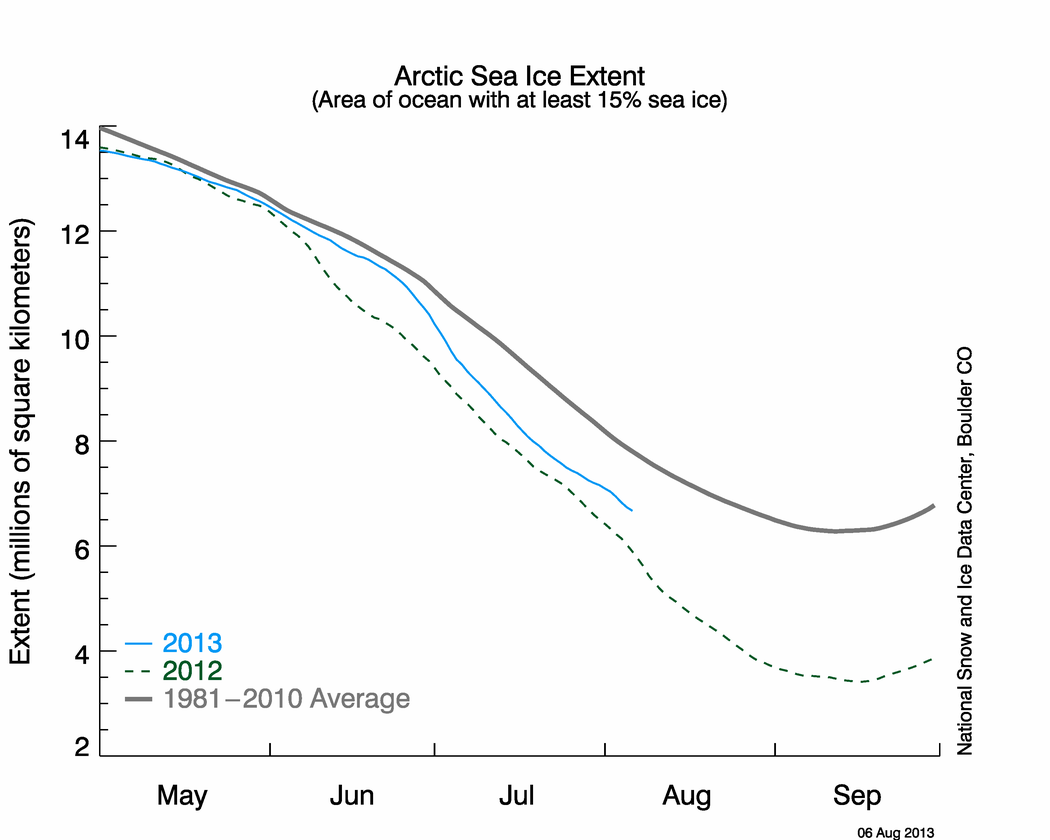
Last edited:
??? Down 7% from an abnormally high level. That doesn't seem like a reason for panic to me.
- Dec 18, 2013
- 136,224
- 27,831
- 2,180
forgive me for the interruption, but I still don't see what the danger is even if the arctic melted. It is all sea ice, it will have no affect on sea level. But I caveat it that I know the ice isn't melting. But, if it did, so what?
??? Down 7% from an abnormally high level. That doesn't seem like a reason for panic to me.
Old Rocks
Diamond Member
- Thread starter
- #6
ATHROPOLIS Guide to Arctic Sunrise and Sunset
September
1 SUN ALL DAY
for 22 more days The sun comes up for
18 hours 20 minutes The sun comes up for
14 hours 50 minutes
2 SUN ALL DAY
for 21 more days The sun comes up for
18 hours 00 minutes The sun comes up for
14 hours 43 minutes
3 SUN ALL DAY
for 20 more days The sun comes up for
17 hours 40 minutes The sun comes up for
14 hours 36 minutes
4 SUN ALL DAY
for 19 more days The sun comes up for
17 hours 21 minutes The sun comes up for
14 hours 28 minutes
5 SUN ALL DAY
for 18 more days The sun comes up for
17 hours 03 minutes The sun comes up for
14 hours 21 minutes
6 SUN ALL DAY
for 17 more days The sun comes up for
16 hours 45 minutes The sun comes up for
14 hours 14 minutes
7 SUN ALL DAY
for 16 more days The sun comes up for
16 hours 28 minutes The sun comes up for
14 hours 06 minutes
8 SUN ALL DAY
for 15 more days The sun comes up for
16 hours 11 minutes The sun comes up for
13 hours 59 minutes
9 SUN ALL DAY
for 14 more days The sun comes up for
15 hours 55 minutes The sun comes up for
13 hours 52 minutes
10 SUN ALL DAY
for 13 more days The sun comes up for
15 hours 38 minutes The sun comes up for
13 hours 45 minutes
11 SUN ALL DAY
for 12 more days The sun comes up for
15 hours 22 minutes The sun comes up for
13 hours 37 minutes
12 SUN ALL DAY
for 11 more days The sun comes up for
15 hours 06 minutes The sun comes up for
13 hours 30 minutes
13 SUN ALL DAY
for 10 more days The sun comes up for
14 hours 51 minutes The sun comes up for
13 hours 23 minutes
14 SUN ALL DAY
for 9 more days The sun comes up for
14 hours 35 minutes The sun comes up for
13 hours 15 minutes
15 SUN ALL DAY
for 8 more days The sun comes up for
14 hours 20 minutes The sun comes up for
13 hours 08 minutes
16 SUN ALL DAY
for 7 more days The sun comes up for
14 hours 05 minutes The sun comes up for
13 hours 01 minutes
17 SUN ALL DAY
for 6 more days The sun comes up for
13 hours 49 minutes The sun comes up for
12 hours 54 minutes
18 SUN ALL DAY
for 5 more days The sun comes up for
13 hours 34 minutes The sun comes up for
12 hours 47 minutes
19 SUN ALL DAY
for 4 more days The sun comes up for
13 hours 19 minutes The sun comes up for
12 hours 40 minutes
20 SUN ALL DAY
for 3 more days The sun comes up for
13 hours 05 minutes The sun comes up for
12 hours 33 minutes
21 SUN ALL DAY
for 2 more days The sun comes up for
12 hours 50 minutes The sun comes up for
12 hours 26 minutes
OCTOBER No sun all day XXXXX Sun is up less than 12 hours XXXXX
BACK TO AUGUST *Twilight less than 12 hours XXXXX Sun is up more than 12 hours XXXXX
BACK TO TOP *Twilight more than 12 hours XXXXX Sun is up all day XXXXX
*NOTE: "Twilight" refers to enough light coming from the Sun when it is below the horizon to not require turning your lights on. Although there is also twilight before and after each time the sun appears in the sky, it has only been shown for days when the sun does not appear ( to indicate a transition ).
Copyright © 1999 Athropolis Productions Limited.

Really, Ian, why don't you research a bit before making such statements. The sun is up at the start of September for

September
1 SUN ALL DAY
for 22 more days The sun comes up for
18 hours 20 minutes The sun comes up for
14 hours 50 minutes
2 SUN ALL DAY
for 21 more days The sun comes up for
18 hours 00 minutes The sun comes up for
14 hours 43 minutes
3 SUN ALL DAY
for 20 more days The sun comes up for
17 hours 40 minutes The sun comes up for
14 hours 36 minutes
4 SUN ALL DAY
for 19 more days The sun comes up for
17 hours 21 minutes The sun comes up for
14 hours 28 minutes
5 SUN ALL DAY
for 18 more days The sun comes up for
17 hours 03 minutes The sun comes up for
14 hours 21 minutes
6 SUN ALL DAY
for 17 more days The sun comes up for
16 hours 45 minutes The sun comes up for
14 hours 14 minutes
7 SUN ALL DAY
for 16 more days The sun comes up for
16 hours 28 minutes The sun comes up for
14 hours 06 minutes
8 SUN ALL DAY
for 15 more days The sun comes up for
16 hours 11 minutes The sun comes up for
13 hours 59 minutes
9 SUN ALL DAY
for 14 more days The sun comes up for
15 hours 55 minutes The sun comes up for
13 hours 52 minutes
10 SUN ALL DAY
for 13 more days The sun comes up for
15 hours 38 minutes The sun comes up for
13 hours 45 minutes
11 SUN ALL DAY
for 12 more days The sun comes up for
15 hours 22 minutes The sun comes up for
13 hours 37 minutes
12 SUN ALL DAY
for 11 more days The sun comes up for
15 hours 06 minutes The sun comes up for
13 hours 30 minutes
13 SUN ALL DAY
for 10 more days The sun comes up for
14 hours 51 minutes The sun comes up for
13 hours 23 minutes
14 SUN ALL DAY
for 9 more days The sun comes up for
14 hours 35 minutes The sun comes up for
13 hours 15 minutes
15 SUN ALL DAY
for 8 more days The sun comes up for
14 hours 20 minutes The sun comes up for
13 hours 08 minutes
16 SUN ALL DAY
for 7 more days The sun comes up for
14 hours 05 minutes The sun comes up for
13 hours 01 minutes
17 SUN ALL DAY
for 6 more days The sun comes up for
13 hours 49 minutes The sun comes up for
12 hours 54 minutes
18 SUN ALL DAY
for 5 more days The sun comes up for
13 hours 34 minutes The sun comes up for
12 hours 47 minutes
19 SUN ALL DAY
for 4 more days The sun comes up for
13 hours 19 minutes The sun comes up for
12 hours 40 minutes
20 SUN ALL DAY
for 3 more days The sun comes up for
13 hours 05 minutes The sun comes up for
12 hours 33 minutes
21 SUN ALL DAY
for 2 more days The sun comes up for
12 hours 50 minutes The sun comes up for
12 hours 26 minutes
OCTOBER No sun all day XXXXX Sun is up less than 12 hours XXXXX
BACK TO AUGUST *Twilight less than 12 hours XXXXX Sun is up more than 12 hours XXXXX
BACK TO TOP *Twilight more than 12 hours XXXXX Sun is up all day XXXXX
*NOTE: "Twilight" refers to enough light coming from the Sun when it is below the horizon to not require turning your lights on. Although there is also twilight before and after each time the sun appears in the sky, it has only been shown for days when the sun does not appear ( to indicate a transition ).
Copyright © 1999 Athropolis Productions Limited.

Really, Ian, why don't you research a bit before making such statements. The sun is up at the start of September for

Ice-free waters off of Greenland and the Canadian Islands increase glacial flow into the ocean. The glacier outlets aren't ice-jammed, the warming ocean waters can erode the base of the glaciers more, and a lack of sea ice means warmer air temperatures near the coastline.
Could you explain the reasoning that you you used to come to that ridiculous conclusion?
What part about a trend line going down don't you understand?
- Dec 18, 2013
- 136,224
- 27,831
- 2,180
hahahahahhahahaha, you can make that line tilt in different ways by changing the axis number to represent 10 square miles vs three and that line isn't as severe, so to represent chaos they choose 3 as the number on the axis. Try ten, try 20, let's see how that line looks. Funny how again, everything is always panic mode with you.What part about a trend line going down don't you understand?
hahahahahhahahaha, you can make that line tilt in different ways by changing the axis number to represent 10 square miles vs three and that line isn't as severe, so to represent chaos they choose 3 as the number on the axis. Try ten, try 20, let's see how that line looks. Funny how again, everything is always panic mode with you.What part about a trend line going down don't you understand?
Yup. If you look at the actual whole record of arctic ice extent then the decline is still noticeable but hardly the 'death spiral' that it is made out to be.
Old Rocks
Diamond Member
- Thread starter
- #14
Really, Ian?
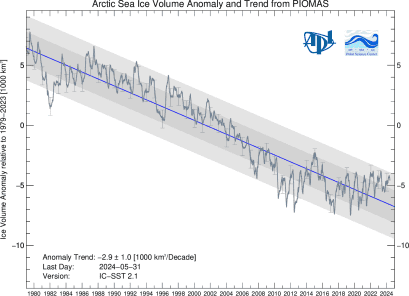
Fig.1 Arctic sea ice volume anomaly from PIOMAS updated once a month. Daily Sea Ice volume anomalies for each day are computed relative to the 1979 to 2014 average for that day of the year. Tickmarks on time axis refer to 1st day of year. The trend for the period 1979- present is shown in blue. Shaded areas show one and two standard deviations from the trend. Error bars indicate the uncertainty of the monthly anomaly plotted once per year.
Polar Science Center PIOMAS Arctic Sea Ice Volume Reanalysis

Fig.1 Arctic sea ice volume anomaly from PIOMAS updated once a month. Daily Sea Ice volume anomalies for each day are computed relative to the 1979 to 2014 average for that day of the year. Tickmarks on time axis refer to 1st day of year. The trend for the period 1979- present is shown in blue. Shaded areas show one and two standard deviations from the trend. Error bars indicate the uncertainty of the monthly anomaly plotted once per year.
Polar Science Center PIOMAS Arctic Sea Ice Volume Reanalysis
- May 20, 2009
- 144,099
- 66,367
- 2,330
Supposedly it involves albedo. Of course the lowest ice extent is in Sept when the sun is dipping below the horizon. And open ocean loses a lot more heat when it isn't insulated with ice.
Chinese soot.
Old rocks needs to move to China
- Dec 18, 2013
- 136,224
- 27,831
- 2,180
Nice graph shows the recovery NicelyReally, Ian?
Fig.1 Arctic sea ice volume anomaly from PIOMAS updated once a month. Daily Sea Ice volume anomalies for each day are computed relative to the 1979 to 2014 average for that day of the year. Tickmarks on time axis refer to 1st day of year. The trend for the period 1979- present is shown in blue. Shaded areas show one and two standard deviations from the trend. Error bars indicate the uncertainty of the monthly anomaly plotted once per year.
Polar Science Center PIOMAS Arctic Sea Ice Volume Reanalysis
you guys get lost in navel gazing. theatrical graphs made to emphasize some horror that only exists in your minds.
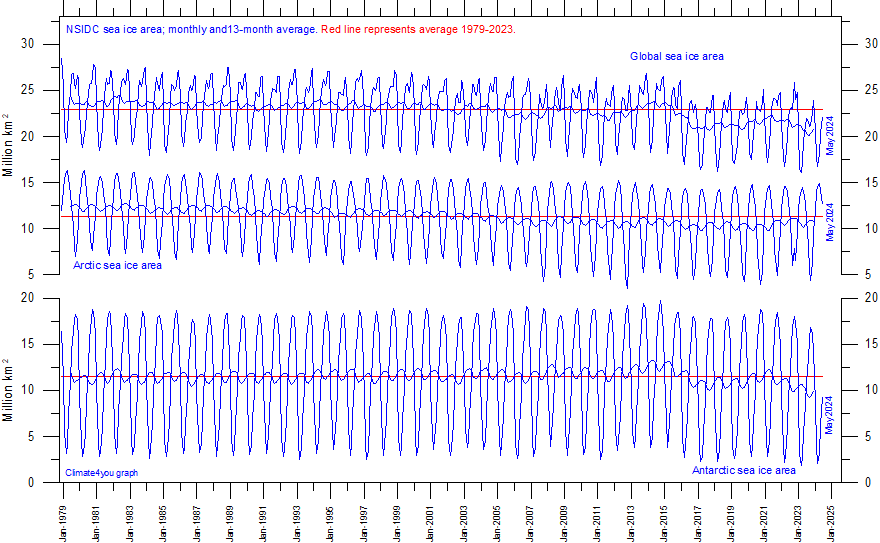
has there been a decrease in the Arctic? yes. but was 1979 an average year? doubtful. the Arctic expands and contracts on a yearly basis but it is not a random value every year. one low yearly value contributes to lower values for several years. one high value also contributes for several years. did the high value in '79 skew the values as much as the low one in 2007? perhaps, more data is needed.
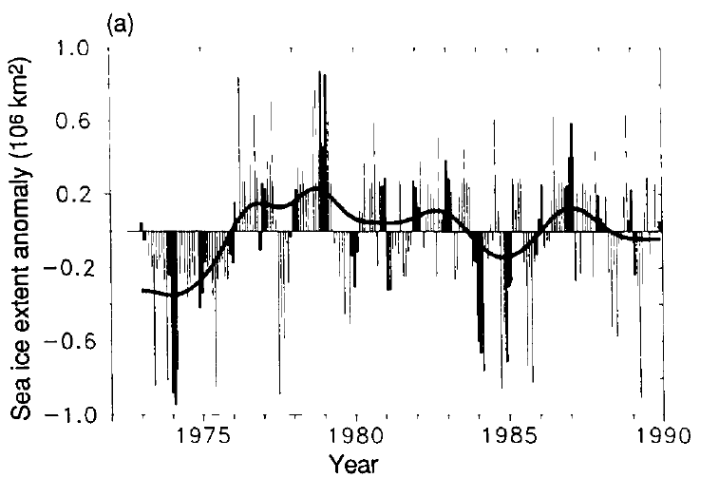
this IPCC graph appears to show 1979 arctic sea ice levels much higher than 1974 levels.
Really, Ian?
Fig.1 Arctic sea ice volume anomaly from PIOMAS updated once a month. Daily Sea Ice volume anomalies for each day are computed relative to the 1979 to 2014 average for that day of the year. Tickmarks on time axis refer to 1st day of year. The trend for the period 1979- present is shown in blue. Shaded areas show one and two standard deviations from the trend. Error bars indicate the uncertainty of the monthly anomaly plotted once per year.
Polar Science Center PIOMAS Arctic Sea Ice Volume Reanalysis
seems to me we argued about 5 years ago when PIOMAS changed up its version of computer model and recent ice volumes plummeted. you do realize that the graph is not real data, right?

to be honest, I dont know how NSIDC measures the age of ice. salinity maybe? when storms blew out much of the multi year ice in 2007 and 2012 it certainly caused a major drop in average age and total volume. conditions since 2012 seem to be favouring increased multiyear ice formation. we shall see whether your death spiral is real, or if Arctic sea ice extent is cyclical.
Similar threads
- Replies
- 118
- Views
- 2K
- Replies
- 7
- Views
- 288
- Replies
- 10
- Views
- 333
Latest Discussions
- Poll
- Replies
- 37
- Views
- 482
- Replies
- 626
- Views
- 7K
- Replies
- 175
- Views
- 1K
- Replies
- 5
- Views
- 28
Forum List
-
-
-
-
-
Political Satire 8018
-
-
-
-
-
-
-
-
-
-
-
-
-
-
-
-
-
-
-
ObamaCare 781
-
-
-
-
-
-
-
-
-
-
-
Member Usernotes 467
-
-
-
-
-
-
-
-
-
-

